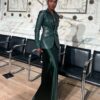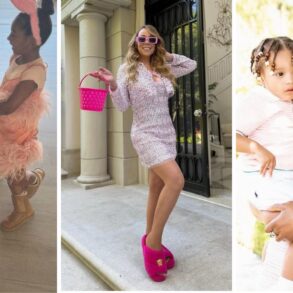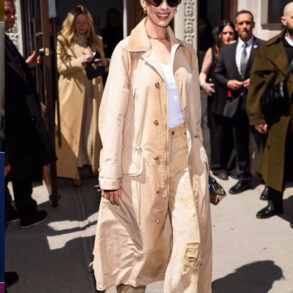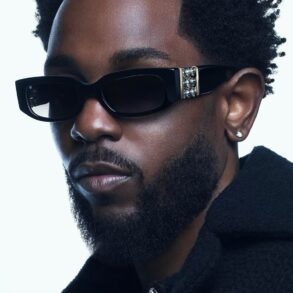I have been airlifted in, along with 80 other slack-jawed journalists, to document the whole affair. I’ve opted for just three days of the fiesta, and already am annoyed at myself for missing the opening party and a performance by Diana Ross.
Arriving at Pettolecchia La Fortezza, a castle that dates back to 1450, the only obvious sign of security is the group of police casually manning the entrance where the fleet of black Mercedes vans is dropping off guests. Given the millions of euros’ worth of jewellery on site, things seem fairly relaxed.

The castle is surrounded by olive groves containing the oldest olive trees in Puglia, which tonight form the backdrop to Dolce & Gabbana’s high jewellery collection. As we walk up the sisal carpet, protecting shoes from the dusty red earth, a harpist plays What a Wonderful World and waiters in gold brocade jackets offer champagne on silver trays.
Housed in freestanding glass cabinets, the jewellery appears suspended in midair against gnarled tree trunks; rubies and diamonds shimmering in the low-lying evening sun. One piece picks up on the local bougainvillea, clusters of tiny flowers picked out in pink sapphires and rubellite tourmalines on a cascading neckpiece and earrings.
There are some classic Dolce & Gabbana motifs (crucifixes, leopards) but the hero pieces play to the setting – a suite of matching designs that pay homage to the olive tree, its leaves and fruit rendered in yellow gold, emeralds and tsavorite garnets.
Acrobatic troupes perform feats as we head to our tables outside for a menu that includes eggplant, burrata and sea bass, accompanied by Dolce & Gabbana’s own range of wines. A performance by Italian bass-baritone Francesco Cascione punctuates the courses; the set includes the Italian classic O Sole Mio.
Portaloos remain the great leveller. No matter what you’ve spent, or what you’re wearing, everyone patiently waits their turn. I’m relieved to not have to navigate the situation in a satin and tulle gown as layered as a millefoglie.
The whole point of the Alta experience, for this level of client, is to offer something that money – alone – can’t buy. Even the most seasoned travel agent would be hard-pressed to pull off something like this.
“Our clients stay for one week,” says Dolce. “This is our big satisfaction, because they have a huge experience. When people come in for holiday for one week, OK, you can visit, but [for example] it is impossible if you come as a tourist to see Alberobello like [you will] tonight.”
He’s not wrong. For the Alta Moda show, which takes place the evening after the high jewellery event, the brand has taken over the entire town, famous for its trulli, the little round houses with unique cone-shaped roofs. The locals are on board and many are part of the action.




Crochet and other design elements of the Alta Moda collection are a nod to the heritage of the town of Alberobello.
As guests walk down the Via Monte Nero, they are met by the villagers dressed in traditional clothes, showcasing local skills such as weaving or making bread and taralli, those moreish doughnut-shaped biscuits that appear on so many aperitivo plates across Italy. Those inhabitants not part of the official mise en scene are enjoying the excitement, including a group of teens sitting atop a trullo, iPhones in hand, gleefully waving at passersby.
The street eventually gives way to the town square, where a catwalk looped like one of those taralli is backed by tiered benches – to avoid any perceived favouritism, clients are left to choose their own seats. Decorative screens form backdrops and the town is granted star status, its name up in lights.
Speaking of, celebrity-spotting ascends to a whole new level, to the delight of guests and locals. First there’s Helen Mirren, chatting with Christian Bale on the front row, then Kerry Washington is spotted with her hair piled high. Kris Jenner arrives in a feather-trimmed tiger-print robe, while Rosie Huntington-Whiteley looks sunkissed in a white bandeau top and skirt. Last to arrive is Kim Kardashian, in a grape-hued taffeta wrap gown that casually slips off one shoulder to reveal a hint of black corsetry beneath.




A model wears a basket-weave dress and a trullo-inspired headpiece
The clients are having their moment in the spotlight, too. At the Paris haute couture shows, those who are there to shop rarely crack a smile. Not here. If Paris puts the haughty in haute, then Alta Moda is the carnivale of couture. Clients relish the opportunity to wear their most extravagant looks, and every facet of the Dolce & Gabbana woman and man is on display tonight.
Men in silk pyjama sets and beaded Roman tunics join women in gold carapaces, black lace sheaths and one who appears to have a Sicilian ruin balanced on her head. That’s the beautiful thing about this event; you can channel princess, sexy widow or the Temple of Concordia and no one bats an eyelid.
As the sun sets, the first model appears wandering down a cobbled street and onto the catwalk, wearing a sheer black dress over corsetry. The look is topped off with an enormous hat in the shape of a trullo’s roof. The lace and lingerie theme continues for a while, until a cape appears that is artfully appliqued and embroidered into a scene from the town we are looking at.
Crafty elements that nod to the town’s heritage follow, including corsets and minidresses woven like baskets, and dresses and robes finished off with crochet. A couple of looks are reminiscent of aprons worn by the women we’ve just seen making pasta. By Dolce & Gabbana standards, this was restraint incarnate.
“This is a very special show because it is the most autentico show we make in our life,” said Dolce at the press conference that occurred earlier that afternoon. “It is completely the opposite to the last season. For the first time, no one sees sequins, diamonds, only the work, only crochet. It is rustico rurale. We make the clothes to cook the tomatoes in the alta moda way. Why not? Alta moda is the sense of fatto a mano [made by hand]. Tutto fatto a mano.”
He noted that even the simplest looking lace dresses were far from it, using multiple fabrics in a technique similar to intarsia, not patchwork. “We take our inspiration from the roots of the village,” added Gabbana.
Heading up the hill to dinner, the locals are now handing out baskets filled with their famous crafts and delicacies, such as linen, porcelain trinkets and taralli. In a cordoned-off square, tables are set with red-and-white gingham tablecloths, and matching cherry tomatoes and mini bocconcini.




Helen Mirren, Kim Kardashian and influencer Pelayo Diaz.
Angela Bassett is sitting alone at one of the tables. I take a rare fangirl moment to introduce myself and ask for a picture, and she happily obliges. Five minutes later, still hunting for my table, I hear my name being called. I look around and, unbelievably, it’s Bassett. She’s curious to know where the baskets everyone is carrying came from. I explain, and add that mine won’t fit in my already-heaving luggage for the trip back to Australia, and she can have it – minus the taralli.
The locals have again been co-opted into the action, this time to cook dinner for the guests. Huge vats of orecchiette are being prepared with three sauces to choose from: beef or octopus ragu, and rocket and tomato. Tonight there are no waiters, everyone queues. Helen Mirren happily carries two plates of pasta back to her table, while the pink-crimped Venus Williams surveys the offerings, trying to decide.




A dinner table at the Alberobello event.
After dinner comes the dancing. Brazilian model Alessandra Ambrosio, in a gold capelet, is swaying her hips in a group with Dolce. To the strains of It’s Raining Men, three small girls in crystal slides start posturing with glee and Lucien Laviscount from Emily in Paris offers some tremendous twerking, after which he heads off laughing. When Dancing Queen comes on, I can’t help myself. Looking for a safe spot to leave my clutch, I quickly conclude that this is an occasion when nobody’s likely to steal off with it.
Back at Borgo Egnazia for the next day’s press conference, Dolce is ordering caffe leccese for everyone. This iced black coffee with almond syrup, a speciality of the province of Lecce that forms the heel of Italy’s boot, keeps us cooled and caffeinated.
“We do this for 10 years and we improve little by little, we invest a lot in the beginning and now everything has come back,” says Gabbana of the Alta Moda experience. “Our important thing, from the beginning – we celebrate 40 years [next] September of Dolce & Gabbana – is the love. We put our love in everything we do – in the alta moda, in the pret-a-porter, in the fragrance, in the make-up, in the jewels. Everything is our life.”
The press conferences are relaxed yet highly managed affairs. The pair rarely give one-on-one interviews any more, following a series of gaffes that caused the brand to be dubbed by The New York Times′ Vanessa Friedman as “a poster child for cultural ignorance”.
There was fallout in 2015 when Dolce commented that IVF kids of gay couples were “chemical children”. It sparked the hashtag #BoycottDolceGabbana, which was supported by the likes of Elton John and Courtney Love. The hashtag got another spin thanks to the brand’s sartorial support of Melania Trump. (Their comeback was to print T-shirts with the #BoycottDolceGabbana slogan.)




The brand made the hashtag its own.
In 2016 came the pom-pom-finished “slave sandal” (eventually renamed “decorative flat sandal”). Two years later, Gabbana said, in terms of succession, he didn’t want a Japanese designer to take over the label.
But the big one came in November 2018, when the brand released an ad campaign before its Great Show, a catwalk extravaganza planned for Shanghai. In the ad, a Chinese model tries to eat Italian food with chopsticks. The campaign was swiftly branded culturally insensitive and racist. Matters got even worse when DMs between Gabbana and an Instagram user were leaked to fashion’s Instagram morality police Diet Prada, in which Gabbana equated the country of China to turd emojis. The show was cancelled, and the fallout has haunted the brand for years.
The brand’s resurrection has been under way since. The early 2019 awards season was a Dolce-free zone, but it was only a few months later that celebrities started wearing the brand to big events again. Fashion has a notoriously short memory after all, especially when beautiful clothes are at stake.
Several retailers dropped the brand at the time, including online giant Net-a-Porter, but most have since come back on board. (Hong Kong’s Lane Crawford is still a holdout.) Certainly none of the past controversy seems to concern the clients attending the Alta Moda experience, who hail from all over the globe – the Middle East, Peru, India and yes, even China.
En route to today’s press conference, there had been much discussion among our posse about the shopping process. Is it truly done via WhatsApp from the moment the clothes hit the catwalk? The designers soon confirm this. “All the clients have one person they are connected with, one buyer [from the company], and sometimes they fight over the same clothes,” says Dolce.
“This one is mine. No, is mine!” jokes Gabbana.
“The priority is the first message to arrive,” says Dolce. It soon becomes clear why tensions can run high. Sometimes, in haute couture, a house might sell multiples of a design as long as the clients live in different regions. “We don’t make repetition or similar, we make one [look] in the world,” he says. “It’s funny, sometimes one dress – 10 [potential buyers]. Some dresses – nobody.”
Australia has just one couple entering the fray: Jaimee and James Kennedy, of the Kennedy Luxury Group. As well as being loyal clients decked top-to-toe in the brand for this week, they have a working relationship as exclusive stockists of Dolce & Gabbana fine jewellery in Australia. This is their second Alta Moda in a row, and Jaimee, creative director of Kennedy’s soon-to-be-released jewellery line, says it is “so much more than the experience of a lifetime”.
“Every year we come away having met incredible people and making great friends from around the world,” she says. “You can’t help but be inspired.”
For this year’s celebration, Jaimee has worn a combination of alta moda and custom ready-to-wear pieces, which she buys directly from the house. (In Australia, Dolce & Gabbana has just opened the doors to its new store in the Sydney CBD, which joins its one other location in Melbourne.) Jaimee’s accompanying hairstyles, including a sweeping updo festooned with flowers, courtesy of her travelling hairstylist Sarah Laidlaw, are worthy of an alta parrucchiera tag.




Looks from the Alta Sartoria show in Ostuni.
Her other travelling companion, photographer Liz Sunshine, takes images of her finished looks, which are duly splashed over Instagram and in a later Kennedy newsletter with the headline: “Take an exclusive look into the world of alta moda and discover Italian excellence on the catwalk with Jaimee Belle Kennedy in her latest report.”
The limewashed “white city” of Ostuni and its Piazza della Liberta is the scene for the Alta Sartoria show. At a front table, one client has taken his seat, dressed in a midnight-blue velvet robe trimmed with crystals. He is shirtless but wears a sautoir necklace in bold jewels that hangs to the waistline of his metallic trousers.
He is channelling the fall of the Roman Empire, but it’s further proof that this experience is a chance for clients to play out their fashion fantasies with a like-minded crowd. Locals are watching from every vantage point, and one chain-smoking nonna in an orange dress has the best seat in the house from her first-floor balcony.
To kick off proceedings, the designers have pulled off another coup: a special staging of la Cavalcata di Sant’Oronzo, a centuries-old horse parade held every August that pays homage to the patron saint said to have spared the city from a plague in 1657. “I have never seen in my life, only the pictures,” enthuses Gabbana before the show, in which riders and horses alike are robed in red attire extravagantly embellished in silver sequins and embroidery.
“It’s in the mood of Dolce & Gabbana because it’s very baroque. Today we have the privilege to use this cavalcata for all the audience.” A couple of the horses seem a little tetchy to begin, but they remain steadfast as the collection plays out.
While there is more sparkle than the women’s collection the night before, the overarching theme for the night is an homage to another Italian tradition, the corredo. “Usually in the south of Italy when a baby girl [is born], the mother starts to make a bridal chest – the vest for night, the blanket, everything in white or beige linen full of embroidery,” says Gabbana.
“The idea in the beginning was to do something like this for the women [in alta moda] but in the end we decide to use this for men. Because it’s more interesting to watch a very typical Italian female work on the man’s clothes. So we make the jacket, coat, shirt, trousers, everything with this type of tablecloth, full of embroidery.”
As the show progresses, things become a little more decorative and Dolce & Gabbana-esque. To finish, some moulded plastic breastplates, a nod to the ceramics from the nearby town of Grottaglie.
The fleet of vans swiftly ferries guests once again to the post-show dinner and dancing that Gabbana has promised, this time at the Cala Maka beach club. While waiting at the bar, a South American client and repeat Alta Moda attendee says he has made some great friends at these events, again citing la famiglia. “Although they’re family I only ever see here.”
In the line-up for the loos, a guest has a blister brewing and another quickly offers a Compeed, bringing a sense of camaraderie. Wandering around the indoor-outdoor venue where a relaxed dinner is unfolding, there are some recognisable pieces of jewellery spotted on the ears and fingers of clients from the Alta Gioielleria presentation two nights earlier. Clearly the merchandise is moving. While jewellery offers an instant fix of retail therapy, the clothes will still be months in the making. Fatto a mano. In Dolce & Gabbana’s utterly unique way.
The Fashion issue of AFR Magazine is out on Friday, August 25 inside The Australian Financial Review.
This post was originally published on this site be sure to check out more of their content.








